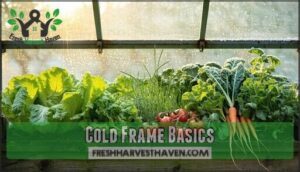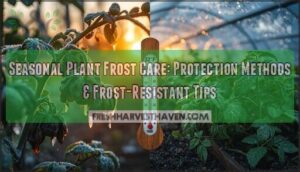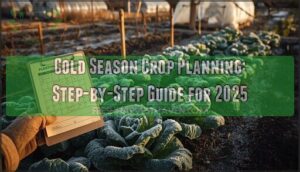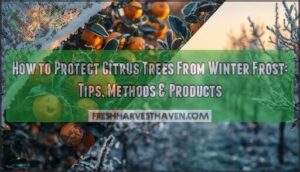This site is supported by our readers. We may earn a commission, at no cost to you, if you purchase through links.
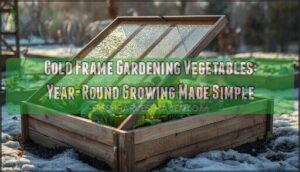
You’ll grow fresh greens like spinach, kale, and lettuce through winter’s chill, while herbs like parsley and cilantro thrive in these protective mini-greenhouses.
These simple structures capture solar heat during the day and release it at night, creating a microclimate that’s typically 5-10 degrees warmer than outside temperatures.
Think of cold frames as nature’s thermostat – they automatically regulate conditions for cool-season crops that would otherwise succumb to frost.
The beauty lies in their simplicity: just a slanted glass or plastic top over a bottomless box.
Most gardeners discover their cold frames reveal secrets about soil preparation, ventilation timing, and crop selection that dramatically boost their harvest success.
Table Of Contents
- Key Takeaways
- Cold Frame Basics
- Choosing Cold Hardy Crops
- Building a Cold Frame
- Cold Frame Maintenance
- Cold Frame Gardening Techniques
- Extending Growing Season
- Frequently Asked Questions (FAQs)
- Can you grow vegetables in a cold frame?
- What are the disadvantages of cold frames?
- Are there any vegetables that can be planted in October?
- When should you start using a cold frame?
- How to use a cold frame for vegetables?
- What is the most cold tolerant vegetable?
- What are the disadvantages of a cold frame?
- When should you plant in a cold frame?
- What vegetables are good in a cold frame?
- What are the most cold tolerant vegetables?
- Conclusion
Key Takeaways
- You’ll extend your harvest season by 4-6 weeks using cold frames that maintain temperatures 5-10°F warmer than outside conditions, letting you grow fresh vegetables when others can’t
- You can grow cold-hardy crops like spinach, kale, lettuce, and carrots year-round by selecting varieties that actually improve in flavor after frost exposure
- You’ll need proper ventilation management – opening frames when temperatures exceed 75°F and closing before sunset – to prevent overheating while maintaining optimal growing conditions
- You can build effective cold frames using simple materials like cedar lumber and salvaged windows, with basic construction skills creating season-extending protection for under $150
Cold Frame Basics
You’ll discover that cold frames are simple glass or plastic-topped boxes that create a protective microclimate for your vegetables.
These bottomless structures trap solar heat during the day and release it slowly at night, extending your growing season by up to 6 weeks while protecting plants from frost, wind, and harsh weather, which effectively extends your growing season.
Definition and Purpose
A cold frame functions as nature’s thermostat, creating a protective microclimate that transforms your gardening possibilities.
This bottomless box with its transparent lid captures sunlight during the day and releases stored heat at night, establishing controlled environment conditions that extend your growing season by weeks or even months.
Through microclimate creation, you’ll maintain temperatures 5-10°F warmer than surrounding areas.
The structure provides essential plant protection from harsh winds, frost, and temperature swings that would otherwise damage tender crops.
Season extension techniques become simple when you harness this natural greenhouse effect.
Cold frame gardening delivers emotional rewards that go beyond fresh vegetables:
Experience the satisfaction of growing fresh food when others can’t – cold frames make winter abundance possible.
- Freedom from winter grocery store dependencies
- Pride in harvesting while neighbors’ gardens sleep
- Security knowing weather won’t control your harvest
- Joy from sharing year-round homegrown produce
- Confidence mastering frost protection methods.
This controlled environment opens doors to growing cold weather crops throughout winter, making year-round gardening accessible to every home gardener seeking gardening benefits.
Materials and Construction
Building your cold frame starts with Site Selection – you’ll need level ground with southern exposure to capture maximum sunlight.
Material Costs and Frame Durability vary substantially depending on your approach to cold frame design.
| Material | Cost | Lifespan |
|---|---|---|
| Cedar lumber | $75-150 | 10-15 years |
| Pine/plywood | $25-75 | 3-7 years |
| Recycled materials | $10-50 | Variable |
Glazing Options include storm windows, polycarbonate panels, or greenhouse plastic.
Cold frames create a protective microclimate for sensitive plants.
Storm windows provide excellent insulation, while polycarbonate offers superior durability for active cold frame gardening.
Your DIY Plans require basic carpentry skills and standard tools.
Most building materials work well when you match quality to your budget and climate needs.
Types of Cold Frames
With gardening season lasting longer than ever, choosing the right cold frame design makes all the difference for successful vegetable growing.
Each type offers unique advantages depending on your space, budget, and cold frame gardening goals.
Here are the most popular cold frame design options:
- Wooden Frames – Cedar or pine construction with glass tops provides classic durability and natural insulation
- Polycarbonate Models – Modern panels deliver superior light transmission and weather resistance for year-round use
- Poly Tunnels – Lightweight, portable structures perfect for protecting larger growing areas and multiple crops
- Upcycled Materials – Repurposed storm windows and salvaged lumber create budget-friendly DIY cold frame solutions
- Cloche Types – Individual glass bells or plastic covers offer targeted protection for specific plants
Your frame materials and cold frame plans should match your gardening ambitions and local climate conditions.
Benefits of Cold Frame Gardening
You’ll discover that cold frame gardening transforms your Winter Harvests into a reliable source of fresh produce.
This simple technique provides excellent Weather Protection while delivering impressive Season Extension that stretches your growing window by 4-6 weeks.
Your frost protection plants thrive in temperatures 5-10°F warmer than outside conditions.
Space Efficiency maximizes every square foot, making cold frame gardening perfect for small yards.
You’ll enjoy substantial Cost Savings on grocery bills, especially with early spring crops and hardy vegetables.
Cold frame benefits include natural pest protection and year-round extending growing season capabilities.
Choosing Cold Hardy Crops
You’ll want to focus on cold-hardy vegetables that can handle winter temperatures and still produce quality harvests.
The key is selecting crops that both survive and actually improve in flavor when exposed to cold conditions, turning your cold frame into a productive winter garden.
Suitable Vegetables for Cold Frames
Your garden’s success hinges on choosing the right cold-hardy crops for extended growing seasons.
Leafy Greens like spinach and kale actually sweeten after frost, thriving in temperatures as low as 4°C.
Root Vegetables including carrots and radishes develop enhanced flavor when cold activates their natural sugar storage.
Brassica Crops such as bok choy handle freeze-thaw cycles exceptionally well, while Winter Herbs like parsley maintain active growth under protection.
- Spinach remains harvestable at soil temperatures down to 4°C
- Carrots continue growing in cold frame gardening below 7°C
- Kale withstands overnight temperatures to -10°C
Crop Selection for Winter Gardening
Smart crop selection for winter vegetable gardening starts with understanding your local growing conditions.
Know your zone, match your crops, harvest success all winter long.
Cold hardy vegetables like spinach, mâche, and claytonia thrive in protected environments, while root crops such as carrots develop enhanced sweetness after frost exposure.
Your coldframe success depends on matching frost tolerance with seasonal planning. By choosing the right cold tolerant crops, gardeners can enjoy a variety of fresh produce year-round.
5 Winter Crop Selection Priorities:
- Temperature thresholds – Choose overwintering vegetables rated below your zone’s average lows
- Harvest windows – Select coolseason crops with staggered maturity dates
- Space efficiency – Pick compact varieties maximizing coldframe real estate
- Growth patterns – Favor low-growing winter crops fitting frame height
- Succession potential – Plan multiple plantings for continuous harvests
Factors Affecting Crop Choice
Your crop selection success hinges on understanding climate factors and plant hardiness zones.
Soil quality determines root development depth—carrots need loose, deep soil while lettuce thrives in shallow beds.
Consider growth patterns when planning space: compact cool-season crops like spinach maximize cold frame gardening efficiency.
Match cold-hardy crops to your frame’s microclimate and winter vegetable gardening goals for optimal harvests.
Understanding cold hardy varieties is vital for a successful winter harvest.
Building a Cold Frame
Building your own cold frame transforms scrap materials into a season-extending powerhouse that’ll keep fresh vegetables growing when winter typically shuts down your garden.
You’ll need basic carpentry skills, some lumber or salvaged windows, and a sunny spot to create this simple but effective growing environment, which can be considered a powerhouse.
Design and Planning
Proper cold frame design begins with understanding your garden’s unique conditions and your growing goals. You’ll create a microclimate that extends your harvest season by carefully planning three key elements before construction starts.
Site Selection forms the foundation of successful cold frame gardening. Choose level ground with southern exposure to capture maximum winter sunlight. Position your frame near south-facing walls when possible – these structures provide wind protection and reflect additional warmth. Avoid low-lying areas where cold air settles, and verify good drainage to prevent waterlogged soil.
Frame Materials directly impact your cold frame’s performance and longevity. Consider these options for Microclimate Control:
- Cedar frames with glass tops – Premium durability lasting 10-15 years with excellent heat retention
- Reclaimed storm windows over wooden boxes – Budget-friendly DIY cold frame solutions under $50
- Polycarbonate panels – Modern lightweight option providing superior insulation and light transmission
Garden Layout planning maximizes Space Efficiency in small growing areas. Design your cold frame plans with 12-inch back height sloping to 8 inches front for ideal sun exposure. This angled design sheds rain while capturing low winter sun rays effectively.
Materials and Tools Needed
Building your cold frame requires careful selection of Frame Materials and Gardening Tools to guarantee long-term success.
Cedar lumber offers the best durability for cold frame construction, lasting 10-15 years compared to pine’s 3-7 years. Your DIY cold frame plans should include polycarbonate panels or repurposed storm windows for glazing.
Here’s what you’ll need for cold frame design:
- Building Supplies – galvanized screws, hinges, and corner brackets for weather resistance
- Garden Tools – drill, circular saw, level, and measuring tape for precise assembly
- Insulation Options – weatherstripping, caulk, and foam board for sealing gaps
- Soil Preparation materials – thermometer for monitoring growing conditions
Quality materials make the difference between a cold frame that lasts one season versus decades of reliable performance. When selecting materials, consider the benefits of cedar lumber products for enhanced durability.
Step-by-Step Construction Guide
Why struggle with complex construction when building your cold frame can be straightforward and rewarding? Start your cold frame construction by assembling the wooden frame on level ground, guaranteeing the back panel reaches 12 inches high while the front measures 8 inches for proper water drainage.
Material Selection matters—pre-drill holes in cedar boards to prevent splitting, then secure joints with galvanized screws for weather resistance. These Construction Tips guarantee lasting Frame Design.
Install your chosen glazing—old windows work perfectly for DIY Plans. Mount hinges on the back edge, creating easy access for your cold frame gardening activities. These proven Building Techniques transform basic materials into functional garden protection that’ll serve you for years.
Tips for DIY Cold Frame Building
Smart Frame Materials sourcing starts with salvaged windows and reclaimed lumber—you’ll slash costs by 70%.
DIY Plans work best when you repurpose storm doors for spacious growing areas. Add Building Tips like foam board insulation and strategic hinge placement for easy ventilation.
These Cold Frame Construction shortcuts deliver professional results without breaking your budget, making DIY Gardening accessible for every skill level.
Understanding cold frame benefits is essential for a successful year-round garden.
Cold Frame Maintenance
Proper cold frame maintenance keeps your vegetables thriving while protecting your investment in season extension equipment.
You’ll need to master three essential areas: temperature control through ventilation, moisture management, and seasonal upkeep tasks that guarantee favorable growing conditions year-round.
Ventilation and Temperature Control
Temperature-control mastery transforms your cold frame from a plant sanctuary into a thriving microclimate powerhouse. Your frame’s interior can reach 86°F even when outside temperatures hover around 50°F, making Air Circulation essential for plant survival.
Effective Ventilation Systems prevent heat stress through strategic management:
- Open lids when internal temperatures exceed 75°F using manual props or hinges
- Install automatic vent openers with temperature-sensitive wax cylinders for hands-free Climate Control
- Monitor daily with thermometers to maintain ideal Temperature Regulation between 65-75°F
Heat Retention during cold nights requires closing frames before sunset, while microclimate management demands consistent airflow to prevent fungal diseases and maintain healthy growing conditions. Properly installed ventilation devices are vital for maintaining a stable environment.
Watering and Humidity Management
Proper watering and humidity control in your cold frame can make the difference between thriving vegetables and failed crops.
You’ll need to monitor soil moisture levels carefully, watering only when the top inch feels dry.
Winter vegetables typically require less water than summer crops due to reduced evapotranspiration rates.
Effective moisture management prevents common problems while conserving water:
- Use drip irrigation systems to deliver water directly to roots, avoiding wet foliage
- Open your frame on warm days to reduce humidity levels and prevent condensation buildup
- Check soil hydration by inserting your finger two inches deep before watering
Morning watering works best, allowing excess moisture to evaporate before evening temperatures drop.
This evaporation management strategy reduces fungal disease risks while maintaining proper soil moisture.
You’ll typically water twice weekly during winter months, adjusting frequency based on weather conditions and plant needs.
Seasonal Care and Maintenance
Your cold frame’s needs change dramatically with each season. Winter Protection requires weekly inspections for damage and adding extra insulation during severe cold snaps. Check Ventilation Control systems regularly to prevent moisture buildup that causes plant diseases.
Spring brings rapid temperature swings requiring daily monitoring. Gradually increase airflow as warmth returns. Summer Storage means propping lids fully open to prevent overheating your vegetable garden.
Fall Preparation includes deep cleaning glazing panels for maximum light penetration and repairing any structural damage. Focus on Soil Management by adding compost and checking drainage systems.
Frost Prevention becomes critical during shoulder seasons. Harvest Timing adjustments help maximize yields before temperature drops. Monthly maintenance of hinges, weatherstripping, and cold frame ventilation systems prevents costly repairs.
This seasonal approach to cold frame maintenance keeps your cold frame gardening productive year-round through consistent seasonal gardening practices.
Cold Frame Gardening Techniques
Mastering cold frame gardening techniques transforms your vegetable growing from seasonal to year-round success.
You’ll learn proper sowing methods, soil preparation, plant care, and harvesting strategies that maximize your cold frame’s potential for continuous fresh produce.
Sowing and Planting in Cold Frames
With your cold frame maintained, successful planting hinges on timing and technique. Begin cold frame sowing when soil temperatures reach 40°F consistently. Winter planting requires patience – you’re working with nature’s slower rhythm, not fighting against it.
Seed selection matters more in cold frame gardening than summer growing. Choose varieties bred for cool conditions, as they’ll handle temperature swings better than their heat-loving cousins.
Here’s your planting roadmap:
- Start sowing seeds at proper depths – typically 1/8" to 1/4" for leafy greens
- Follow plant spacing guidelines religiously to prevent overcrowding and disease
- Use soil prep techniques that promote drainage while retaining moisture
- Practice succession planting every 2-3 weeks for continuous harvests
- Plan for hardening off seedlings started indoors before transplanting
Cold frame usage becomes intuitive once you understand that seedlings need gradual exposure to outdoor conditions. Think of it like adjusting your eyes to bright sunlight – sudden changes shock the system.
Soil Preparation and Fertilization
Before soil testing reveals your garden’s needs, soil preparation becomes the cornerstone of successful cold frame vegetables.
Test your pH levels first—aim for 6.0-7.0 for ideal nutrient balance. Mix soil amendments like compost at 50% ratio with existing soil, creating perfect drainage needs while boosting fertility.
Organic fertilizers applied before planting supply essential winter nutrition. Consider using a soil pH meter to accurately assess your soil’s condition.
Think of it as meal-prepping for your plants—you’re setting them up for months of success. Well-amended soil retains warmth better than neglected dirt, giving vegetables the steady foundation they need to thrive through cold seasons.
Pruning and Training Plants
Smart Cold Frame Pruning maximizes your growing space through strategic Shaping Plants techniques.
Regular Training Techniques prevent overcrowding while directing Vertical Growth for maximum light exposure.
Essential Plant Support strategies:
- Pinch growing tips weekly to encourage bushier, compact development
- Remove lower leaves blocking light from reaching younger plants below
- Install wire supports for climbing vegetables like peas and beans
These pruning techniques guarantee proper air circulation throughout your cold frame gardening season.
Harvesting and Storage Tips
Peak harvest timing means checking your cold frame daily once plants reach maturity. Harvest timing depends on each crop’s specific needs and growth rate in the protected environment.
Proper cleaning starts immediately after picking. Rinse vegetables gently with cool water, removing all soil and debris. Postharvest handling requires careful drying to prevent rot during storage.
Storage methods vary by vegetable type:
| Vegetable | Storage Duration |
|---|---|
| Leafy greens | 1-2 weeks |
| Root vegetables | 2-4 months |
| Brassicas | 2-3 months |
| Herbs | 1-3 weeks |
| Radishes | 3-4 weeks |
Cold frame curing works well for root crops like carrots and beets. Leave them in the frame for several days after maturity to concentrate sugars. Extending shelf-life requires proper temperature control and humidity management during storage duration.
Extending Growing Season
You can stretch your garden’s productivity far beyond traditional growing seasons by using cold frames strategically throughout the year.
These simple structures turn winter’s harsh conditions into manageable challenges, letting you harvest fresh vegetables when neighbors are buying expensive produce at the grocery store, allowing you to enjoy fresh vegetables.
Using Cold Frames for Early Seed Starting
Transform your garden into a productive powerhouse by using cold frames to get a head start on the growing season.
These protective structures create perfect conditions for early spring crops, warming soil temperatures 5-10°F above outdoor conditions while shielding young plants from unpredictable weather.
Cold frame gardening allows you to start seeds weeks earlier than traditional outdoor planting.
The controlled environment promotes faster germination and stronger seedling development.
Proper seedling hardening occurs naturally as you gradually increase ventilation, preparing plants for successful transplanting.
- Soil warming accelerates seed germination through consistent temperature control
- Moisture control maintains ideal humidity levels without waterlogging delicate roots
- Pest prevention creates a physical barrier against insects and small animals
Effective light management and frost protection guarantee your early plantings thrive, giving you fresh vegetables while neighbors are still planning their gardens.
Overwintering Perennials and Vegetables
While early seed starting gets your garden off to a strong start, overwintering lets you maintain fresh harvests through winter’s toughest months.
Your cold frame becomes a protective sanctuary where cold-hardy crops like kale and Brussels sprouts develop natural cold hardiness through cellular adaptations.
These dormancy strategies help plants survive freezing temperatures while maintaining quality.
Layer mulch around root zones for perennial protection and reduce watering to prevent rot.
Winter gardening requires monitoring soil moisture weekly – plants need consistent but minimal water.
Position your cold frame gardening setup to capture maximum winter sunlight.
This frost protection method basically creates natural root cellaring conditions, allowing continuous winter harvest of fresh vegetables when grocery store prices peak.
Protecting Plants From Frost and Extreme Weather
Beyond protecting overwintering vegetables, your cold frame becomes a shield against nature’s harsh extremes.
Frost protection transforms your simple structure into a weather fortress. Polycarbonate cold frames boost internal temperatures up to 7°F above outside air, while double-layered coverings slash frost damage by 35%. Understanding frost damage mechanisms is vital for effective protection strategies.
Winter gardening success depends on these frost protection strategies:
- Layer insulation materials like bubble wrap or row covers during severe cold snaps
- Position strategically near south-facing walls for heat absorption and wind protection
- Install heat sinks such as black water jugs to maintain overnight warmth
Monitor with thermometers to guarantee your cold insulation keeps coldhardy crops thriving through winter’s worst weather.
Year-Round Gardening With Cold Frames
Cold frame gardening transforms your growing space into a year-round production system.
These structures provide microclimate control that maintains temperatures 5-10°F warmer than outside conditions, enabling continuous winter harvesting of cold-hardy crops.
Your cold frame design creates the foundation for successful extended growing season cultivation.
Position frames strategically to maximize sun exposure while protecting plants from harsh winds.
Season extension becomes achievable through proper ventilation management and insulation techniques.
Smart gardening tips include rotating crops seasonally and monitoring soil moisture levels consistently.
| Season | Best Crops |
|---|---|
| Spring | Lettuce, spinach |
| Summer | Herbs, transplants |
| Fall | Radishes, arugula |
| Winter | Carrots, mâche |
| Year-round | Scallions, parsley |
This approach guarantees fresh vegetables regardless of weather conditions outside.
Frequently Asked Questions (FAQs)
Can you grow vegetables in a cold frame?
Picture rows of vibrant greens thriving beneath frost-covered glass while snow blankets your garden.
You can absolutely grow vegetables in cold frames year-round, extending harvests by protecting plants from harsh weather conditions, using cold frames to achieve this.
What are the disadvantages of cold frames?
You’ll face limited growing space, require daily ventilation monitoring, and need protection during extreme weather. Initial setup costs vary, and glazing materials may break, requiring maintenance and replacement over time.
Are there any vegetables that can be planted in October?
October’s golden window opens wide for hardy vegetables that laugh at frost. You can plant spinach, lettuce, arugula, radishes, and kale in cold frames, where they’ll thrive through winter’s chill.
When should you start using a cold frame?
You should start using your cold frame in early fall, around September or early October, to protect tender plants and extend harvests through winter months.
How to use a cold frame for vegetables?
Like planting seeds of hope in winter’s embrace, you’ll place cold-hardy vegetables inside your frame, close it before sunset to trap warmth, and open it on sunny days for ventilation.
What is the most cold tolerant vegetable?
Spinach tops the cold-tolerance charts, surviving temperatures down to 15°F when established. Kale and Brussels sprouts follow closely, handling single-digit freezes. These hardy vegetables actually sweeten after frost hits.
What are the disadvantages of a cold frame?
Like a greenhouse with a stubborn streak, cold frames demand daily attention for ventilation.
They risk overheating plants on sunny days, offer limited growing space.
They can’t protect against extreme cold snaps, and these limitations highlight the challenges of using cold frames.
When should you plant in a cold frame?
You can plant in cold frames during fall for winter harvests and early spring for season extension.
Fall planting works best 8-10 weeks before your first hard frost, giving crops time to mature before growth slows in winter’s shorter days, which is crucial for winter harvests.
What vegetables are good in a cold frame?
Cold-hardy vegetables thrive in cold frames: spinach, kale, lettuce, arugula, bok choy, carrots, radishes, turnips, and herbs like parsley. These crops actually become sweeter after frost exposure.
What are the most cold tolerant vegetables?
Nature’s toughest vegetables laugh at winter’s bitter bite. Spinach, kale, Brussels sprouts, carrots, and parsnips handle freezing temperatures best, actually sweetening after frost exposure enhances their natural sugars.
Conclusion
Master cold frame gardening vegetables through proper construction, plant selection, and maintenance techniques.
You’ll extend growing seasons, protect tender crops, and harvest fresh produce year-round.
Cold frames offer temperature control, frost protection, and ideal growing conditions for cool-season vegetables.
By implementing ventilation strategies, soil preparation methods, and seasonal care practices, you’ll maximize your garden’s productivity.
These simple structures transform ordinary gardens into productive spaces that deliver consistent harvests regardless of weather conditions outside, using proper construction.

